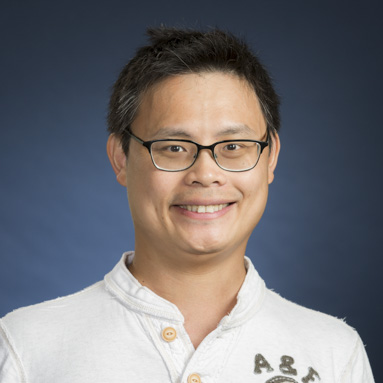Nature Communications Publishes Research Led by Kun-Ta Wu That Illustrates How Active Fluid Promotes Micromixing in Microfluidic Devices
Department(s):
PhysicsMixing is a ubiquitous phenomenon in everyday life, from making a cup of coffee to baking a birthday cake. Mixing takes place through a repeated process of stretching and folding, like kneading dough, as seen in this video. However, mixing fluids at microscopic scale, called micromixing, remains challenging because fluids at this scale behave as laminar flows, and laminar flows cannot stretch and fold fluids.
To address this challenge, Assistant Professor Kun-Ta Wu in the Department of Physics and his PhD student, Teagan Bate, led an international team to introduce “active” fluids that spontaneously form chaotic mixing flows into a microfluid system. Active fluid consumes local fuel to self-flow without the need for an external pump. Wu’s team reported in the journal Nature Communications that introducing active fluid to the microfluidic system reduces the mixing time of suspended components by a factor of about 20—from 24 hours to 1 hour. (See video at right.) Moreover, Wu’s team found that the mixing performance of the active fluid system is controlled by the ratio of convective transport rate to diffusive transport rate, called Péclet number.
Wu’s collaborators on the research include Michael Norton of the Rochester Institute of Technology and Chih-Che Chueh of the National Cheng-Kung University in Taiwan. In addition to experimental characterization, the researchers developed an active fluid model to describe the mixing dynamics of an active fluid system. (See video.)
The research reported in Nature Communications paves the path to the design of microfluidic devices that use active fluids to promote or optimize micromixing, which could enhance production efficiency in chemical and biological engineering and in pharmaceutical development. The work is presented on Wu’s YouTube channel.
The research was partly supported by a prestigious five-year CAREER Award that Wu received from the National Science Foundation in 2021 to characterize and model the mixing and vorticity dynamics of active fluid systems.

Dr. Wu is an active researcher with a focus on soft matter and biophysics, which is an interdisciplinary field that encompasses physics, biology, and engineering. His work centers on the study of active fluids, which are a class of soft materials that comprise self-propelling particles capable of generating their own motion without the need for external forces or energy sources. Dr.
Are You a Journalist in Need of a Source?
Faculty members and senior administrators are available to offer ideas, opinions, analysis, and commentary on issues ranging from higher education to current events, trending topics, and breaking news.
Keep Up With WPI Research News
Want to learn more about Research at WPI? Subscribe to the monthly newsletter.